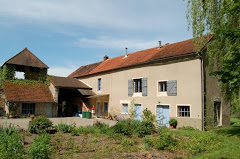 The connection between those two subjects was not immediately clear, but that would undoubtedly be revealed during the lecture. And although we were expecting guests for our gîte that day, we had decided that on early arrival of those guests (which they did) we could attend the evening. So on the night concerned we drove up to Salle Beun, the village house, where everyone in our village who could read was gathered.
The connection between those two subjects was not immediately clear, but that would undoubtedly be revealed during the lecture. And although we were expecting guests for our gîte that day, we had decided that on early arrival of those guests (which they did) we could attend the evening. So on the night concerned we drove up to Salle Beun, the village house, where everyone in our village who could read was gathered.The object of this particular Blog is not to give a run down on the lecture itself. But one has to admit, that Gilles Plattret, historian, writer, journalist, politician and lecturer (he appears to be quite popular as “conférancier” - meaning stand-up comedian in Dutch! - in Saône-et-Loire) delivered an excellent story about how the war started, what the influence was of the line of demarcation (which ran not far from Cormatin) between “free” Vichy France and its occupied northern counterpart, when and how the resistance movement started and what the influence was of de Gaulle in ’40-’45 in communities like Cormatin. The lecture was illustrated with a projection of images of this period. No need to say, that those who were born and brought up in Cormatin regularly threw in remarks and comments about the contents of those pictures.
 What I found most interesting during the presentation was the personalized way Plattret interacted with his audience. Of course our Monsieur P. was prominently there. Plattret told several anecdotes, in which Monsieur P.’s father (deported and victim of the camps), and Monsieur P. himself (deported and survivor of Buchenwald) played an important role. But not only Monsieur P.’s name was mentioned. Several (even for us) well known names were mentioned, of whom in many cases the descendants were amongst the audience.
What I found most interesting during the presentation was the personalized way Plattret interacted with his audience. Of course our Monsieur P. was prominently there. Plattret told several anecdotes, in which Monsieur P.’s father (deported and victim of the camps), and Monsieur P. himself (deported and survivor of Buchenwald) played an important role. But not only Monsieur P.’s name was mentioned. Several (even for us) well known names were mentioned, of whom in many cases the descendants were amongst the audience.This evening proved to me that a presentation about history, no matter how well documented and presented, certainly gains accessibility for a bigger public when the presenter somehow has personal ties with the subject and with the audience itself.
I was well impressed. and I will keep an eye out for the name of Gilles Plattret as of now.
For our own website click here.


I stumbled on a bit of French resistance history on a walk from Ameugny over to Mont and spent a bit of time pondering what the quiet valley below would have looked like in May 1944 - http://bit.ly/b5TkcQ
ReplyDelete